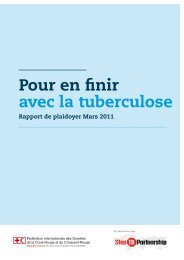Thailand - Stop TB Partnership
Thailand - Stop TB Partnership
Thailand - Stop TB Partnership
You also want an ePaper? Increase the reach of your titles
YUMPU automatically turns print PDFs into web optimized ePapers that Google loves.
<strong>TB</strong> Cluster, expansion of this system would improve the efficiency and accuracy of reports,<br />
reduce reporting delays, and facilitate reporting from the private sector as well. Though<br />
manuals and workbooks are reportedly ready for distribution to clinical staff at all levels, 94<br />
the expansion of the system itself was not assured as of December 2005.<br />
Targeting vulnerable populations<br />
Though the NTP has developed some targeted programming for vulnerable groups, including<br />
migrants, prison populations, the urban poor, ethnic minorities, and mobile workers, <strong>TB</strong><br />
experts and NGO workers alike express serious concern about the resurgence of <strong>TB</strong> among<br />
these groups, the lack of official data and information about what many experts consider<br />
to be subepidemics, 95 and the significant barriers such groups face in accessing diagnostic<br />
and treatment services. 96<br />
Migrants<br />
There are strong indications that <strong>TB</strong> is a serious issue among migrant populations from<br />
neighboring Burma, Laos, and Cambodia. Mandatory health testing among migrants<br />
detected 1,766 active <strong>TB</strong> cases in 2003, and a single clinic in the Mae Sot district detected<br />
700 new cases in 2004, 250 of which needed immediate treatment. 97 As the total number<br />
of migrants is unknown, it is difficult to estimate the total <strong>TB</strong> burden among the migrant<br />
population.<br />
Most recent migrants, particularly those from Burma, seek temporary employment<br />
opportunities in <strong>Thailand</strong>, often as undocumented workers. 98 Thus, even if they are<br />
diagnosed with <strong>TB</strong>, many do not complete treatment, and health workers find it difficult to<br />
ensure proper follow-up. 99 In fact, in one analysis, the cure rate for migrants from Burma<br />
is only about 25.8 percent. 100 In the same analysis, the authors note that the DOTS coverage<br />
rate for migrants from Burma was only 22.9 percent, and Burmese migrants had a 66.5<br />
percent default rate. 101 The level of treatment interruption suggested by these figures has<br />
raised growing concern about the rise in primary drug resistance. 102<br />
Many migrants lack official documentation, such as residence and work permits,<br />
and fear deportation if they come into contact with public authorities. Many cannot read<br />
or speak Thai, hampering outreach activities by health workers. Most are poor and lack the<br />
resources to seek out health care. 103 Ethnic minority groups from within <strong>Thailand</strong> face similar<br />
linguistic and financial barriers. To effectively reach these communities, the NTP must<br />
partner closely with community-based organizations and researchers who have the contacts<br />
and linguistic skills to overcome these barriers.<br />
PUBLIC HEALTH WATCH MONITORING REPORTS 53


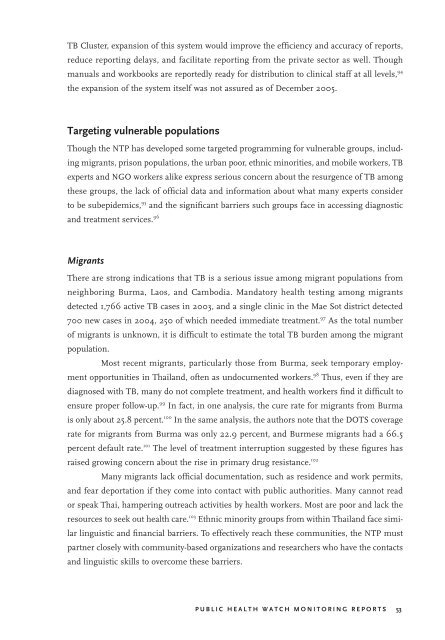
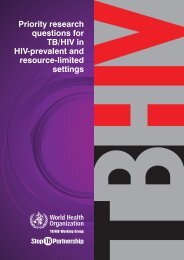
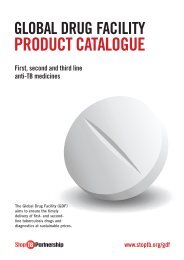
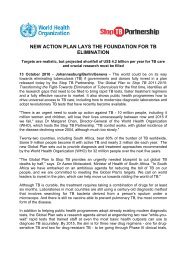
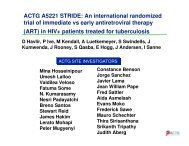
![Global Drug Facility Annual Report 2011 [.pdf] - Stop TB Partnership](https://img.yumpu.com/26788745/1/184x260/global-drug-facility-annual-report-2011-pdf-stop-tb-partnership.jpg?quality=85)

![Concept note on national stop TB partnership [.pdf]](https://img.yumpu.com/26788741/1/184x260/concept-note-on-national-stop-tb-partnership-pdf.jpg?quality=85)
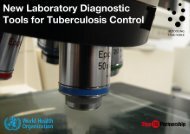

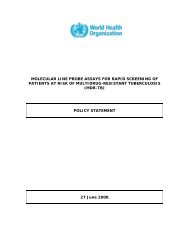
![2005 and Challenges for 2006 - 2015 [.pdf] - Stop TB Partnership](https://img.yumpu.com/26788674/1/190x245/2005-and-challenges-for-2006-2015-pdf-stop-tb-partnership.jpg?quality=85)
![Brochure (French) [.pdf] - Stop TB Partnership](https://img.yumpu.com/17234792/1/190x91/brochure-french-pdf-stop-tb-partnership.jpg?quality=85)

